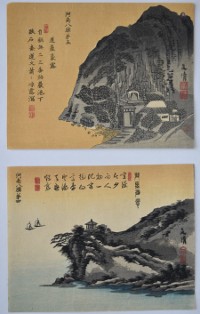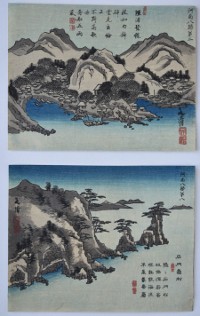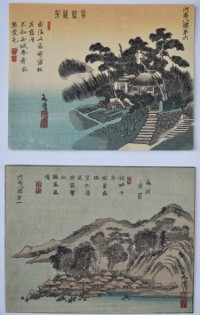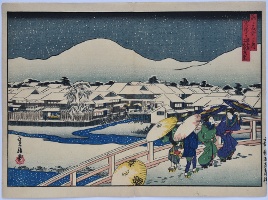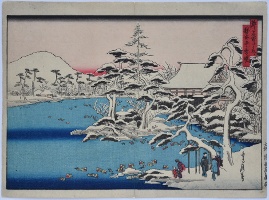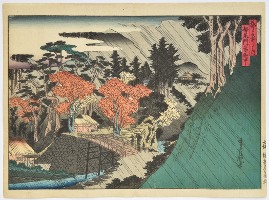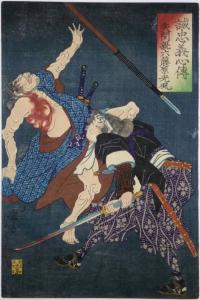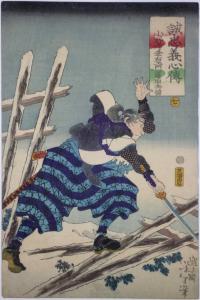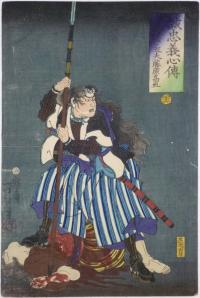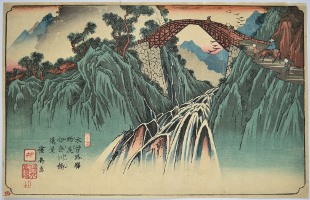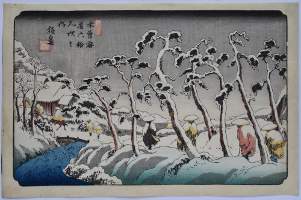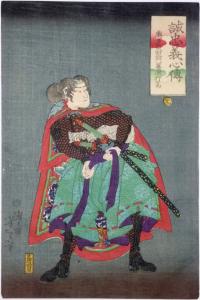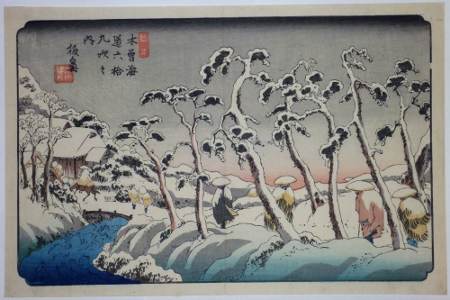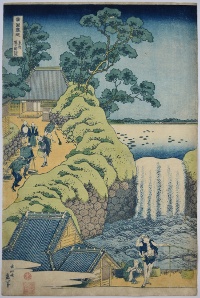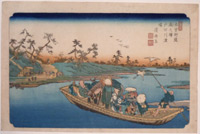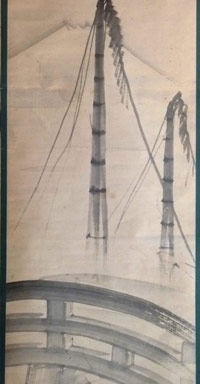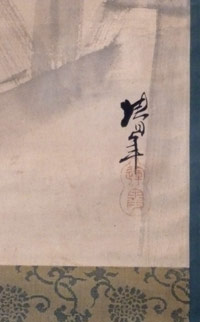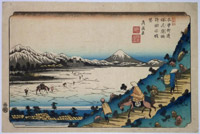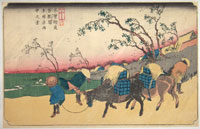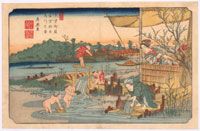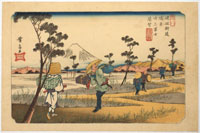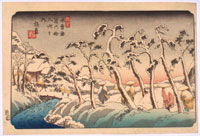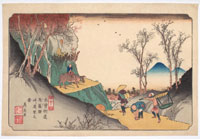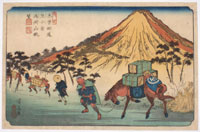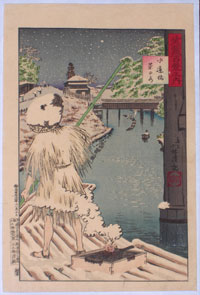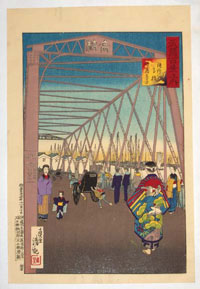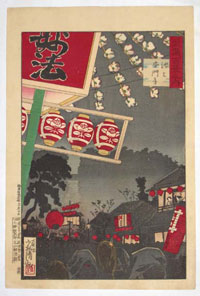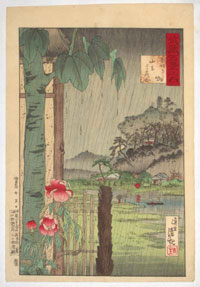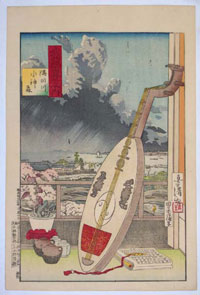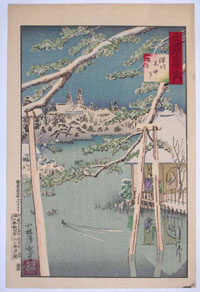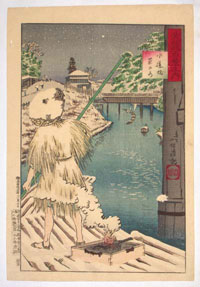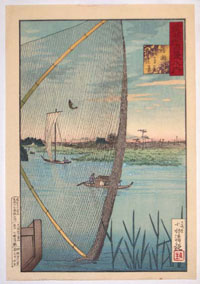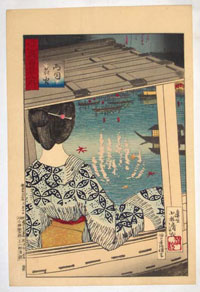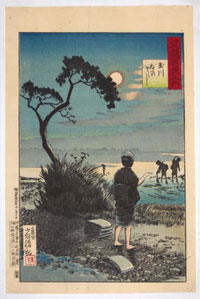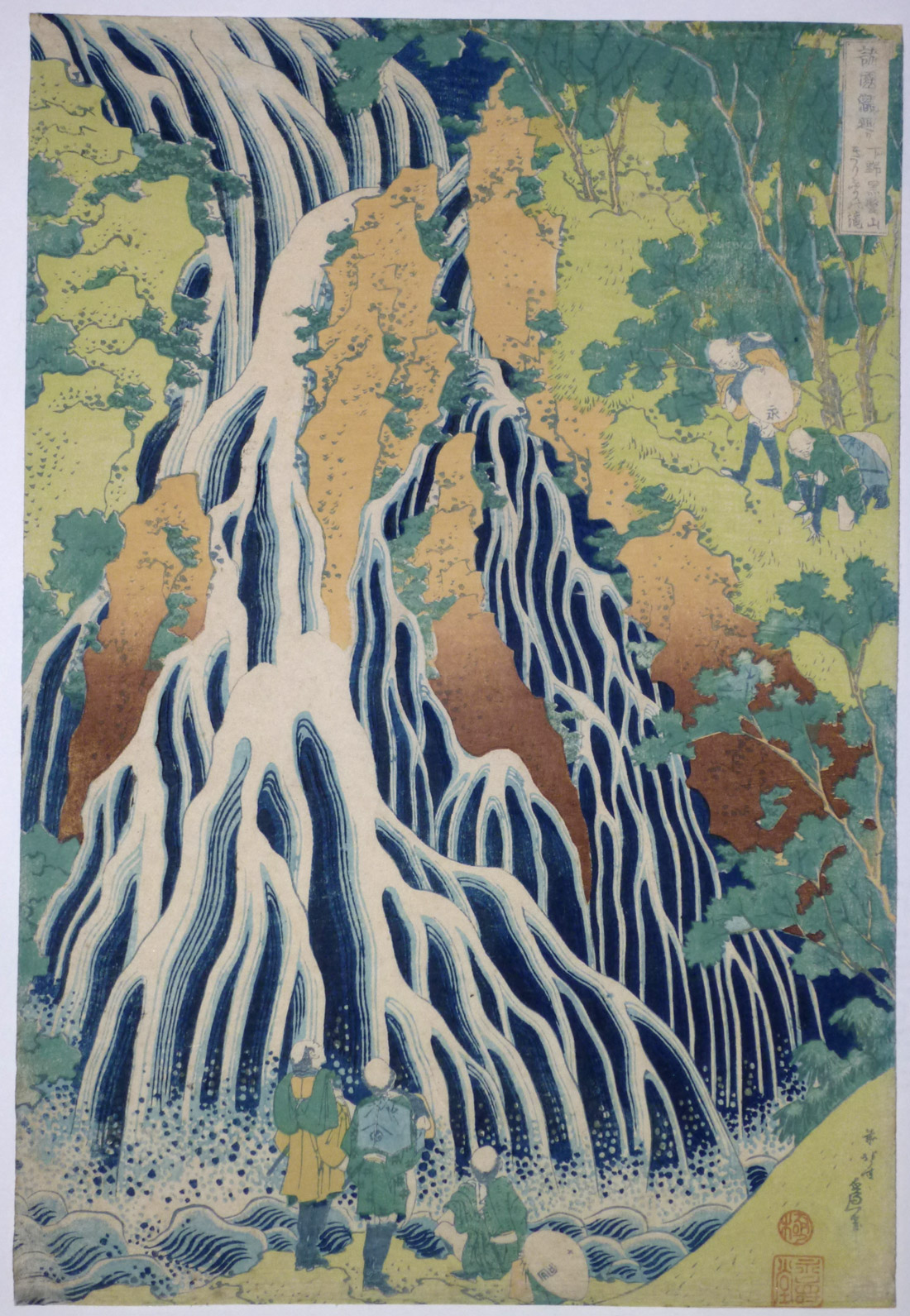Washi – Handmade paper
One of the pleasures of dealing in ukiyo-e is to handle hosho on a daily basis and it is a fact that paper making was already established and used for every imaginable purpose in China and Japan well before Guttenberg was printing the Bible on some of the first western handmade paper.
Hosho, used for printmaking, was manufactured in Echizen and a short- fibred variety of kozo called Nasu Kozo was used. Sumptuous hosho is found on many Harunubu prints and also surimono where a thicker paper was needed to better show off blind printing and where editions were small. Paper is discernably thinner on most Hiroshige sets. Besides kozo, Mitsumata and Gampi fibres were used for paper making but kozo was found to be the most suitable for print making coming from the mulberry family. The trees – in fact one year old sprouts from old stumps – were harvested in December, consequently paper making was an occupation that didn’t interfere with summer farming and the cold weather conditions were also better suited to making paper. The inner white bark of the kozo branches was used to make the bast and this was obtained by steaming the branches and stripping the black and green bark away. The fibre was then boiled in an alkali potash solution to remove the lignin and pectin leaving primarily cellulose fibre. Foreign particles were laboriously removed in cold water (not always successfully as they are found sometimes on 19th century landscapes) The fibre was then beaten or rather loosened to obtain the bast. A mould (su- made of hundreds of rounded bamboo splints woven together with silk threads) was lowered into the vat of bast plus water and a viscous solution of neri (roots from the tororo plant soaked and pounded) to aid formation . An occasional heavier splint gave strength to the mould and this is what is seen when paper is held to the light producing a thinner paper along these strengtheners. Lack of these can be an indication of a later facsimile when machine made paper was used.
For ukiyoe, and especially during the 19th century, a white clay was added to the stock in the vat to lighten the paper and this can cause white blotches to appear over time and are often seen on 19th century landscapes.
The couched paper formed on the su was rolled onto a stack of sheets and very delicately pressed so that the pile weeped. After pressing and parting, the sheets were brushed onto a smooth wooden surface for drying. This gives hosho two distinct sides which can be seen with the eye.
Although print sizes were to some degree determined by the size of the hosho sheets, the primary factor governing formats were the regular government edicts that limited size and thickness.
BUNSEI (Active c. 1830 -1844)
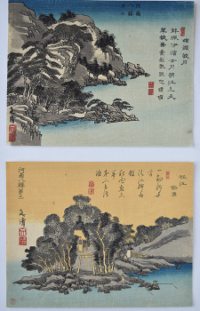
Click here to view image full size.
A complete set of Eight Views of Xiaoxiang, modern Hunan Province, China. These eight views were taken up by Japanese artists such as Hiroshige and transposed to Japan becoming sets like the Eight Views of Omi, etc. Bunsei was a pupil of Tani Buncho. He seems to have made a speciality of this subject and there is a slightly larger version set of the same subject. Published c. 1830s. Provenance: Ex Hayashi with his seal on most of the designs. Rare complete.
Very good impressions and colour. Minor edge wormage, othwerwise very good condition. Each signed Bunsei.
Status: Sold
Utagawa KUNIYOSHI (1797-1861)
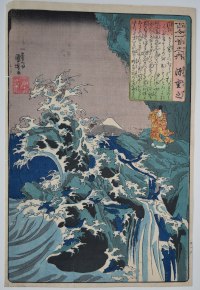
Click here to view image full size.
A poem by the celebrated poet Minamoto no Shigeyuki from the series Hyakunin isshu no uchi, “One Hundred Poems for One Hundred Poets” which was compiled in 1235 by Fujiwara Teika (1162-1241). Shows the poet on a craggy outcrop with waves crashing around him; Fuji in the distance. One of the best designs in the set published by Ebisuya Shoshichi, Ebine, 1840-42. Only 58 of the 100 are known. Various translations of the poem exist, here is one:
Waves that beat against the rocks
Fanned by a fierce wind –
It is I alone
Who breaks, those times
When I think of her
Very fine impression. Fine colour and condition. Signed Ichiyusai Kuniyoshi ga. Hiroshige ga.
Status: Sold
Kikukawa EIZAN (1787-1867)
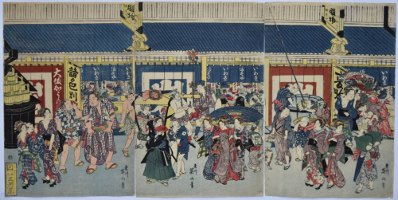
Click here to view image full size.
A triptych showing a street thronged with people in front of the famous department store Iwaki Masuya, giving a good cross-section of the inhabitants of the city at this time. The store specialised in silk and textiles and was one of the most important in Edo having, at one point, 500 employees in its stores. Hiroshige designed another triptych of this subject in c. 1850.
Published by Mikawaya Seiemon, c. 1815. Rare.
Fine impression. Extremely fine fresh colour. Fine condition. Full size. Signed Kikukawa Eizan fude.
Status: Sold
Shotei HOKUJU (1763-1825)
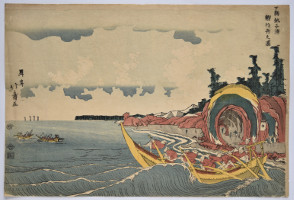
Click here to view image full size.
Shimosa Choshi no ura katsuo tsuribune, “Fishing for Bonito in Choshi Bay in Shimosa Province.” Hokuju, a pupil of Hokusai, produced a number of these fine “westernized” landscapes designed with stylised clouds, cubistic mountains and shadows cast by figures. This is one of the best. Bonito is a favourite fish in Japan where it is in the markets from around May each year. Choshin Bay has always produced the largest seafood catch in Japan. Hokuju produced a substantial body of work in this vein. However, he was not the only one. Okyo, Toyoharu, Hokusai, Kunitora, Kuninao and Shinsai also designed prints in this genre, as well as other artists producing examples. Interestingly, Hiroshige, the pre-eminent landscape artist, designed nothing like this. Indeed, the influences flowed the other way before too long, Hiroshige being a favourite of the Impressionists. This is the rare first edition published by Eijudo, c. 1820. His landscapes were republished by Yamamoto. Rare.
Fine impression and colour. Very good condition. Full size. Signed Shotei Hokuju ga.
Status: Sold
Hasegawa SADANOBU I (1809-1879)
Click here to view image full size.
A chuban landscape from a set of at least 30 prints: Miyako meisho no uchi, “Famous Places in the Capital [Kyoto].” This design, Shijo-bashi yori Nawate-dori Yamato-bashi o nozumo, “View from Shijo Bridge Towards Yamato Bridge at Nawate Street.” A fine set, inspired by Hiroshige, but not slavish copies and some excellent designs (as the snow scene here). Published by Wataya Kihei-ban, 1858.
Fine, early impression. Fine colour and, apart from the usual imperceptible fold, fine condition. Signed Sadanobu ga.
Status: Sold
Hasegawa SADANOBU I (1809-1879)
Click here to view image full size.
A chuban landscape from a set of at least 30 prints: Miyako meisho no uchi, “Famous Places in the Capital [Kyoto].” This design, Ryoan-ji yuki [no] akebono, “Snowy Dawn at Ryoan-ji Temple.” A fine set, inspired by Hiroshige, but not slavish copies and some excellent designs (as the snow scene here). Published by Wataya Kihei-ban, 1858.
Fine, early impression. Fine colour and, apart from the usual imperceptible fold, fine condition. Signed Sadanobu ga.
Status: Sold
Hasegawa SADANOBU I (1809-1879)
Click here to view image full size.
A chuban landscape from a set of at least 30 prints: Miyako meisho no uchi, “Famous Places in the Capital [Kyoto].” This design, Toganoo monzen uchu, “Temple Entrance at Toganoo in the Rain.” A fine set, inspired by Hiroshige, but not slavish copies and some excellent designs (as the rain scene here). Published by Wataya Kihei-ban, 1858.
Fine, early impression. Fine colour and, apart from the usual imperceptible fold, fine condition. Signed Sadanobu ga.
Status: Sold
Tsukioka YOSHITOSHI (1839-1892)
Click here to view image full size.
The ronin Yazama Shinroku Fujiwara Mitsukaze ) from Seichu gishinden, “Tales of True Loyalty.” From a rare uncompleted set of the 47 Ronin published 6/1868 by Masudaya. Thirteen designs extant. It has been suggested that the set was completed but that the others are not known based on the fact that two of the prints are numbered 3 and 46. An error as artists did not commence and progress from number 1. Artists chose at random which numbers from a set to start with. Well known examples being Hiroshige’s Tokaido and Kisokaido.
Very good impression and colour. Small backed wormage and light album backing. Signed Ikkaisai Yoshitoshi hitsu.
Status: Sold
Tsukioka YOSHITOSHI (1839-1892)
Click here to view image full size.
The ronin Okudera Kouemon Fujiwara Hidetomi ( number 7 ) from Seichu gishinden, “Tales of True Loyalty.” From a rare uncompleted set of the 47 Ronin published 6/1868 by Masudaya. Thirteen designs extant. It has been suggested that the set was completed but that the others are not known based on the fact that two of the prints are numbered 3 and 46. An error as artists did not commence and progress from number 1. Artists chose at random which numbers from a set to start with. Well known examples being Hiroshige’s Tokaido and Kisokaido.
Very good impression and colour. Light album backing. Signed Ikkaisai Yoshitoshi hitsu.
Status: Sold
Tsukioka YOSHITOSHI (1839-1892)
Click here to view image full size.
The ronin Muramatsu Sandayu Fujiwara Takano ( number 46 ) from Seichu gishinden, “Tales of True Loyalty.” From a rare uncompleted set of the 47 Ronin published 6/1868 by Masudaya. Thirteen designs extant. It has been suggested that the set was completed but that the others are not known based on the fact that two of the prints are numbered 3 and 46. An error as artists did not commence and progress from number 1. Artists chose at random which numbers from a set to start with. Well known examples being Hiroshige’s Tokaido and Kisokaido.
Very good impression and colour. Small backed wormhole and light album backing. Signed Ikkaisai Yoshitoshi hitsu.
Status: Sold
Keisai EISEN (1790-1848)
Click here to view image full size.
The bridge over the Ina River at Nojiri, Nojiri Inagawabashi enkei, from Kisokaido rokujukyutsugi no uchi , “Sixty-Nine Stations of the Kisokaido.” The set of seventy prints was published by Hoeido in 1835, but in 1837 Hiroshige took over and completed the series with the publisher Iseya Rihei (Kinjudo). The conjecture is that Hiroshige was the better known and more commercial artist, reinforced by the fact that Eisen’s name was removed from the designs already published. Hence only the first editions have his signature on those prints. Shows the cascade beneath the bridge, the underside of which resembles Mount Fuji. Top left, just visible in the mist, are the steps leading to the Kiyomizu Temple of Kiso. (Now a world heritage site, famous for the wooden stage jutting out over the mountainside supported by 139 12-meter high keyaki wood pillars.) One of the best designs from the set. Provenance: Ex Grabhorn collection.
Fine impression. Extremely rare in this early printing: There are a number of different states with alternative colouring to the hills, variant gradation below the falls, losing the blue mountains in the distance and without the flight of geese behind the bridge. Only the first edition has the geese, the blue mountains and the Eisen signature (as here). Fine colour. Margins trimmed a little, otherwise very good condition. Signed Keisai ga.
Status: Sold
Keisai EISEN (1764-1824)
Click here to view image full size.
Itahana from Kisokaido rokujukyutsugi no uchi, “Sixty-Nine Stations of the Kisokaido.” The set of seventy prints was started by Eisen and published by Hoeido in 1835, but in 1837 Hiroshige took over and completed the series with the publisher Iseya Rihei (Kinjudo). One of the best designs from the set. This design is never signed, even, as here, on the first edition. Rare.
Fine impression and colour. This is the first edition with gradation on the river and the river bank. Fine condition.
Status: Sold
Tsukioka YOSHITOSHI (1839-1892)
Click here to view image full size.
The ronin Okuda Sadaemon Fujiwara Yukitaka ( number 42 ) from Seichu gishinden, “Tales of True Loyalty.” From a rare uncompleted set of the 47 Ronin published 6/1868 by Masudaya. Thirteen designs extant. It has been suggested that the set was completed but that the others are not known based on the fact that two of the prints are numbered 3 and 46. An error as artists did not commence and progress from number 1. Artists chose at random which numbers from a set to start with. Well known examples being Hiroshige’s Tokaido and Kisokaido.
Very good impression and colour. Light album backing. Signed Ikkaisai Yoshitoshi hitsu.
Status: Sold
Keisai EISEN (1790-1848)
Click here to view image full size.
Itahana from Kisokaido rokujukyutsugi no uchi, “Sixty-Nine Stations of the Kisokaido.” The set of seventy prints was started by Eisen and published by Hoeido in 1835, but in 1837 Hiroshige took over and completed the series with the publisher Iseya Rihei (Kinjudo). One of the best designs from the set. This design is never signed, even, as here, on the first edition. Rare.
Fine impression and colour. This is the first edition with gradation on the river and the river bank. Slight centre fold, otherwise fine condition. Ex Pulverer collection and purchased from me in 1974.
Status: Sold
Cho Jun and Ri Ki wrestling underwater
In the new offerings is a vertical Yoshitoshi diptych of Cho Jun and Ri Ki wrestling underwater. This is the earliest known state of what is considered one of Yoshitoshi’s best designs – before the first publisher’s name (Matsui Eikichi) and date (20,2,1887) in lower left margin was printed. This gives an opportunity to examine the differences in printing between the earliest and last editions. (The diptych was subsequently reprinted by Hasegawa Tsunejiro in 1,9,1887.)
From the late 18th century there was a history of publishing some prints in a deluxe edition and a more affordable version of the same design: Paper, pigments and nuances in printing could all be adjusted. And by the time we come to some of Hiroshige’s better known sets we find the first editions had great care lavished on them with extra bokashi (grading the pigment by hand), better pigments and paper. The Hundred Views of Edo is a prime example of this: Every care was taken to convey the atmosphere of a scene. Later editions lack these subtleties with commercial considerations taking precedent. This is certainly true of many of Yoshitoshi’s sets as well.
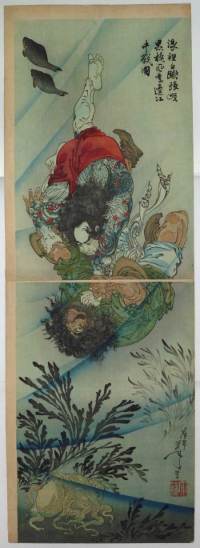
The impression offered here shows all the attributes of the earliest printing: Extremely beautiful and careful wiping of the blue block to render the currents of water; careful modulation of the gradation on the fish at top and also on the sea-weed at the bottom. The later printings – even the first with Matsui Eikichi – lack finesse in the printing of the water and in the republished version there is often no attempt to gradate the foreground sea-weed. The pigments are also of a finer quality on this early state , a better red being used on Cho Jun’s trousers. It was the job of the printers to breathe life, so to speak, into the image, to give form and depth by means of skilled bokashi; to augment a design by wiping on clouds or spraying pigment to imitate dust or snow. This all took time rather than relying on a key-block outline and blocks of colour.The only other difference, of course, between early and late printings is the quality of the impression. The more prints that were pulled, the more the blocks wore down producing weak outlines.
A Twist of Figured Cloth – Shunga wood blocks
This is the first of an occasional blog that I hope clients will find interesting.
In the current update is an important and rare set of six original wood blocks for a shunga (erotic) book Aya no odamaki “A Twist of Figured Cloth” by Terasawa Masatsugu (active c1760-1790) published in 1776 in black and white, so these are the key-blocks (or sumi-blocks) which constitute reversed or mirror-images of the book.
It is pure serendipity that a few original blocks have survived. Many were planed down to recut as wood became more expensive during the 19th century and a lot more were probably used for kindling or destroyed by fire. There is also an apocryphal story that the Victoria and Albert Museum, here in London, burnt a large number of blocks after the Second World War to free up storage space. Early blocks, such as these, are particularly rare. Blocks that survive with big names attached – Harunobu or Hiroshige, for example, are invariably for copies. Shunga blocks are of added rarity. Indeed, this is the only set I have seen . The blocks have a great beauty in their own right and are from the wood of the single-petaled white mountain cherry (shiro-yamasakura or Prunus mutabilis).
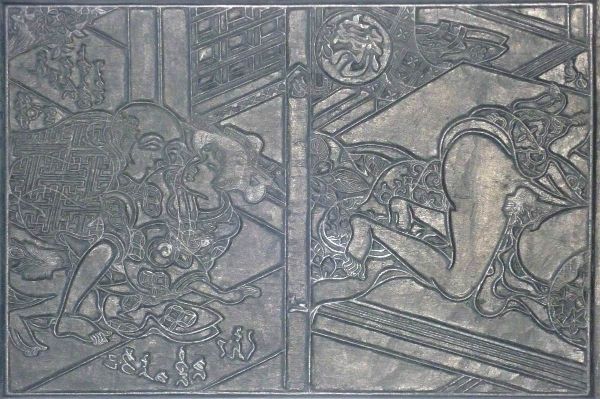
During the Edo period outlines were cut following the direction of the brush strokes of the original drawing, the knife being drawn towards the block-cutter. The block- cutter followed the drawing (hanshita-e) which was pasted face downward onto the block and partially peeled or rubbed with hempseed oil to render it more visible. Cutting was deeper in the 18th century and became shallower during the 19th, probably due to the cost of wood and the gradual sophistication of the cutters. In Japan wood was cut with the grain; this method is fundamentally similar to western chiaroscuro woodcuts, hence the operation is one of relief printing as opposed to intaglio. The impression from the grain of the wood-block was transferred to the paper during printing and is visible on early impressions – an infallible way of recognising genuine impressions rather than copies.
Colour prints used proofs from the key-block to make the colour blocks and were keyed by the simple expedient of marks (notches) cut in the block on the upper and lower left corners. Cutting of a set of blocks could take two or three days while complicated sets were finished within twenty days.
The blocks are priced separately to give as many collectors as possible the opportunity to acquire one, and would sit well with any serious collection of prints, books or shunga.
Utagawa KUNISADA II (1823-1880)
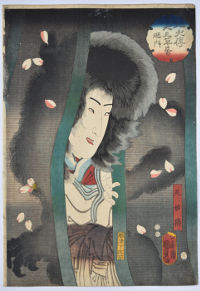
Click here to view image full size.
The actor Segawa Kikunojo V in the role of Ama Myochin, the Cat Witch, from the set Hakkenden inu no soshi no uchi, the Eight Dog Heroes, published by Tsutaya Kichizo, 5/1852. The play was premiered at the Ichimura-za Theatre, 1/1852. This is the highlight of the play: The monstrous cat murders the father of the dog hero Inamura Kakutaro and then assumes his likeness. However, as shown here, its hairy body and giant claws can still be seen behind the bamboo curtain. The best design from the set.
Very fine impression with blind printing and burnishing. Fine colour and condition. This is the only full size impression I have seen as they almost always come from albums and are trimmed to the common denominator. Another (trimmed) impression is illustrated full page in Japanese Prints IV- Hiroshige and the Utagawa school – Rijksprentenkabinet/Rijksmuseum, Amsterdam, 1984, no. 180, page 105. Signed Ichiyosai Kunisada ga.
Status: Sold
Utagawa KUNIYOSHI (1797-1861)
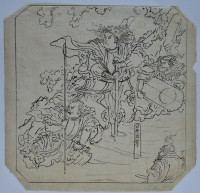
Click here to view image full size.
A fine original sumi drawing (hanshita-e) for an unpublished print for the set Tokaido gojusan tsui, “Fifty-three Parallels for the Tokaido Road.” The set was published by various publishers in 1845-6 and was a collaboration with Kunisada and Hiroshige. Sumi on thin paper. This is a design for the lower half of the oban print, the top half having the title and a panel with the name of the post-station. Shows Yamato Takeru no Mikoto. A legendary prince, son of the Emperor Keiko. Shown here with his retainers.
In extremely good condition. Provenance: Purchased from me in 21/11/1975. Rare.
Status: Available
Katsushika HOKUSAI (1760-1849)
Click here to view image full size.
The Aoigaoka [waterfall] in Edo: Toto Aoigaoka no taki from a set of eight prints with title, Shokoku taki meguri, “A Journey to the Waterfalls of All the Provinces.” A majestic set with a mostly beautiful unifying colour scheme: There is probably no other Hokusai set that has the same impact when viewed complete. Amongst Hokusai’s finest work and much sought after. There are numerous Hiroshige designs based on the same location but they are prosaic in comparison. Eisen, inspired by Hokusai, also produced a set of waterfalls in 1847 which are themselves fine and rare. This particular fall is in fact a spillway for the Tameike reservoir seen above. Aoi Hill near Toranomon Gate to the left. The set published by Eijudo, c. 1832. Rare.
Fine impression. Fine, unfaded colour. Minimal soil and slight trimming on left: These designs are martyrs to trimming and many illustrated examples are trimmed, otherwise very good condition. (This raises an interesting problem because most Hokusai landscapes do not have a black border – contrary to Hiroshige’s – which do, making it easy to judge the trimming on the latter.) Signed Zen Hokusai Iitsu hitsu.
Status: Sold
Keisai EISEN (1790-1848)
Click here to view image full size.
Warabi, one of the Stations from Kisokaido rokujukyutsugi no uchi, “Sixty-Nine Stations of the Kisokaido.” The set of seventy prints was started by Eisen and published by Hoeido in 1835, but in 1837 Hiroshige took over and completed the set with the publisher Iseya Rihei ( Kinjudo ). Warabi no eki Todagawa watashi, “Warabi Station, Ferry on the Toda River.” Shows a ferry with a group of travellers: a pair of goze ( blind singers ); three males with hats; a horse and handler, and a porter smoking in the prow. The Station is seen on the far shore.
Very fine impression of the first edition with signature. Fine colour and condition. Signed Eisen ga.
Status: Sold
Onishi CHINNEN (1792-1851)
Click here to view image full size.
A highly talented artist, he is considered – with Nanrei – to be the finest exponent of the Maruyama-Shijo style in Edo at this time. Of samurai birth, he initially studied under Nangaku and is famous for the highly regarded books: Azuma no teburi, 1829 and Sonan gafu, 1834 ( offered elsewhere on this site ). Shows Fuji looming above masts and a bridge. Possibly the Inari Bridge near the harbour ( shrine ) at Teppozu in Edo. See Hiroshige’s design of this view for the 100 Views of Edo, no. 77. A typically spontaneous Shijo painting. Sumi on paper. Image size 41 x 10.5 in; 105 x 27 cms. Blue paper mounting; grey-blue damask ichimonji with bamboo rollers. Light creasing otherwise good condition with box. Signed Chinnen with seal Unka.
Status: Sold
Keisai EISEN (1790-1848)
Click here to view image full size.
Shiojiri Pass, View of Lake Suwa, from the Sixty-Nine Stations of the Kisokaido. The set was started by Eisen and published by Hoeido in 1835, but in 1837 Hiroshige took over and completed the series with the publisher Iseiri ( Kinjudo ). A view from the pass over the frozen lake towards Takashima Castle, with Mount Fuji in the distance. A short cut over the ice was available in the winter mornings after the ice had frozen during the night. This is the earliest state. Extremely rare.
Very fine early impression. The first state of a number of variants with Take [ nouchi Magohachi ] on the girth of the horse; signature and seals, and gradation on the banks on the right of the print. Combined Take and kiwame seal in left margin. Signed Eisen ga.
Status: Sold
Keisai EISEN (1790-1848)
Click here to view image full size.
Kutsukake no eki Hiratsukahara uchu no kei, ” Kutsukake Station, Rain on the Nearby Plain of Hiratsuka” from the Sixty-nine Stations of the Kisokaido. The set was started by Eisen and published by Hoeido in 1835, but in 1837 Hiroshige took over and completed the series with the publisher Iseiri ( Kinjudo ). A windy autumnal squall over the Hiratsuka flood plain. One of the best Eisen designs from the set. Known in various states and colour variations. The very rare first edition has the signature lower right corner.
Very good impression. Fine colour. Very good condition. Unsigned.
Status: Sold
Keisai EISEN (1790-1848)
Click here to view image full size.
Kuragano Station, Karasu River, Kuragano shuku Karasugawa no zu from the Sixty-nine Stations of the Kisokaido. The set was started by Eisen and published by Hoeido in 1835, but in 1837 Hiroshige took over and completed the series with the publisher Iseiri ( Kinjudo ). Situated at the confluence of three rivers, the Tone, Karasu and Kabura. In spring a ferry service was available down to Edo. The station can be seen on the far shore. Small children play in the foreground watched by a lady taking tea at a rest-stop. This appears to be the earliest state known of this design – earlier than the first edition example illustrated in the NHK exhibition catalogue, Hiroshige: Tokaido and Kisokaido, 2006, pl. 14, p. 43, with greater subtlety in the printing and gradation on the river.
Very fine impression of the first edition. Fine colour. Slight centre fold, otherwise very good condition. Signed Eisen ga.
Status: Sold
Keisai EISEN (1790-1848)
Click here to view image full size.
Konosu from the Sixty-nine Stations of the Kisokaido. The set was started by Eisen and published by Hoeido in 1835, but in 1837 Hiroshige took over and completed the series with the publisher Iseiri ( Kinjudo ). Shows travellers on a zig-zag path that disappears into a range of mountains on the right. To the left, a large Fuji towers over the landscape. The very rare first edition with signature – which is lacking on later states – and differences in colour and gradation. The removal of the signature was presumably because the publishers wanted the public to think the designs were by Hiroshige , the better known landscape artist of the two.
Very fine impression and colour. Extremely large margins. Fine condition. Signed Eisen ga.
Status: Sold
Keisai EISEN (1790-1848)
Click here to view image full size.
Itahana from the Sixty-nine Stations of the Kisikaido. The set was started by Eisen and published by Hoeido in 1835, but in 1837 Hiroshige took over and completed the series with the publisher Iseiri ( Kinjudo ). Shows the entrance to the village with well-wrapped travelers trudging through the snow along a road edged with pines. The sun has set on the horizon. The rare first edition: Other designs from the set are signed on the first edition, but this is the exception. In later editions the red seal, top left, changes; the water in the stream, left, is graded above, not below; the hand-stamped kiwame/Take seal in left margin is left off, and the blue printed on the first figure’s legs and the legs of the two small figures on the bridge is lacking. ( See Ukiyoe Taikei, vol.15, no.15 for an example of the later edition. )
Very fine impression and colour. Two small thin areas right margin and several backed pin holes near border, otherwise fine condition. Unsigned.
Status: Sold
Keisai EISEN (1790-1848)
Click here to view image full size.
Magome from the Sixty-nine Stations of the Kisokaido. The set was started by Eisen and published by Hoeido in 1835, but in 1837 Hiroshige took over and completed the series with the publisher Iseiri ( Kinjudo ).
Fine impression. A rare variant first edition with signature but without the large central mountain. Not listed by Strange. There are later editions without signature and with and without central mountain. Fine colour and condition. Signed Keisai ga.
Status: Sold
Keisai EISEN (1790-1848)
Click here to view image full size.
Oiwake from the Sixty-nine Stations of the Kisokaido. The set was started by Eisen and published by Hoeido in 1835, but in 1837 Hiroshige took over and completed the series with the publisher Iseiri ( Kinjudo ). In the distance is Asama-yama, Mount Asama, a volcano which erupted in 1783. It also emitted debris in 1894 and 1900. This is the extremely rare first edition with signature Keisai and seal bottom left. ( Not in Ukiyo-e Taikei .) Unidentified collector’s seal au verso.
Fine impression and colour. Minor edge soil, otherwise very good condition. Signed Keisai ga.
Status: Sold
Kobayashi KIYOCHIKA (1847-1915)
Click here to view image full size.
Snow at Suidobashi from the set Musashi hyakkei no uchi, the ‘One Hundred Views of Musashi’ ( Musashi being the plain in which Tokyo lies ). The set was modelled on Hiroshige’s 100 Views of Edo but only 34 prints were ever produced by the publisher Kobayashi Tetsujiro in 1884/5.
Fine impression of the first edition. Perfect colour and condition with mica added. Signed Shinseiro Kiyochika ga.
Status: sold
Kobayashi KIYOCHIKA (1847-1915)
Click here to view image full size.
Kyobashi with Tsukuda-jima in the background from the set Musashi hyakkei no uchi, the ?One Hundred Views of Musashi? ( Musashi being the plain in which Tokyo lies ). The set was modelled on Hiroshige?s 100 Views of Edo but only 34 prints were ever produced by the publisher Kobayashi Tetsujiro in 1884/5.
Superb impression of the first edition. Perfect colour and condition with extensive mica. Signed Shinseiro Kiyochika ga.
Status: Sold
Kobayashi KIYOCHIKA (1847-1915)
Click here to view image full size.
The lanterns of Hommonji Temple in Ikegami from the set Musashi hyakkei no uchi, the ‘One Hundred Views of Musashi’ ( Musashi being the plain in which Tokyo lies ). The set was modelled on Hiroshige’s 100 Views of Edo but only 34 prints were ever produced by the publisher Kobayashi Tetsujiro in 1884/5.
Superb impression of the first edition. Perfect colour and condition. Signed Shinseiro Kiyochika ga.
Status: Sold
Kobayashi KIYOCHIKA (1847-1915)
Click here to view image full size.
Rain over the paulownia plantation at Akasaka from the set Musashi hyakkei no uchi, the ?One Hundred Views of Musashi? ( Musashi being the plain in which Tokyo lies ). The set was modelled on Hiroshige?s 100 Views of Edo but only 34 prints were ever produced by the publisher Kobayashi Tetsujiro in 1884/5.
Superb impression of the first edition. Perfect colour and condition. Signed Shinseiro Kiyochika ga.
Status: Sold
Kobayashi KIYOCHIKA (1847-1915)
Click here to view image full size.
The Sumida River and Suijin Forest under heavy rain, a moon-lute in the foreground, from the set Musashi hyakkei no uchi, the ‘One Hundred Views of Musashi’ ( Musashi being the plain in which Tokyo lies ). The set was modelled on Hiroshige’s 100 Views of Edo but only 34 prints were ever produced by the publisher Kobayashi Tetsujiro in 1884/5.
Superb impression of the first edition. Perfect colour and condition. Signed Shinseiro Kiyochika ga.
Status: Sold
Kobayashi KIYOCHIKA (1847-1915)
Click here to view image full size.
Fallen snow at Fukugawa in Benten Province from the set Musashi hyakkei no uchi, the ?One Hundred Views of Musashi? ( Musashi being the plain in which Tokyo lies ). The set was modelled on Hiroshige?s 100 Views of Edo but only 34 prints were ever produced by the publisher Kobayashi Tetsujiro in 1884/5.
Superb impression of the first edition. Perfect colour and condition with extensive mica. Signed Shinseiro Kiyochika ga.
Status: Sold
Kobayashi KIYOCHIKA (1847-1915)
Click here to view image full size.
Snow at Suidobashi from the set Musashi hyakkei no uchi, the ?One Hundred Views of Musashi? ( Musashi being the plain in which Tokyo lies ). The set was modelled on Hiroshige?s 100 Views of Edo but only 34 prints were ever produced by the publisher Kobayashi Tetsujiro in 1884/5.
Superb impression of the first edition. Perfect colour and condition with extensive mica. Signed Shinseiro Kiyochika ga.
Status: Sold
Kobayashi KIYOCHIKA (1847-1915)
Click here to view image full size.
Fishing on Ayase River, Sengenji Temple in the distance from the set Musashi hyakkei no uchi, the ‘One Hundred Views of Musashi’ ( Musashi being the plain in which Tokyo lies ). The set was modelled on Hiroshige’s 100 Views of Edo but only 34 prints were ever produced by the publisher Kobayashi Tetsujiro in 1884/5.
Superb impression of the first edition. Perfect colour and condition with extensive mica. Signed Shinseiro Kiyochika ga.
Status: Sold
Kobayashi KIYOCHIKA (1847-1915)
Click here to view image full size.
Fireworks over Ryogoku from the set Musashi hyakkei no uchi, the ‘One Hundred Views of Musashi’ ( Musashi being the plain in which Tokyo lies ). The set was modelled on Hiroshige’s 100 Views of Edo but only 34 prints were ever produced by the publisher Kobayashi Tetsujiro in 1884/5.
Superb impression of the first edition. Perfect colour and condition with extensive mica. Signed Shinseiro Kiyochika ga.
Status: Sold
Kobayashi KIYOCHIKA (1847-1915)
Click here to view image full size.
Full moon at Tamagawa illuminating dyers at work in the river from the set Musashi hyakkei no uchi, the ‘One Hundred Views of Musashi’ ( Musashi being the plain in which Tokyo lies ). The set was modelled on Hiroshige’s 100 Views of Edo but only 34 prints were ever produced by the publisher Kobayashi Tetsujiro in 1884/5.
Superb impression of the first edition. Perfect colour and condition with extensive mica. Signed Shinseiro Kiyochika ga.
Status: Sold
Home
Welcome to the new site, please browse the catalouge for categories, click here for new acquisitions.
